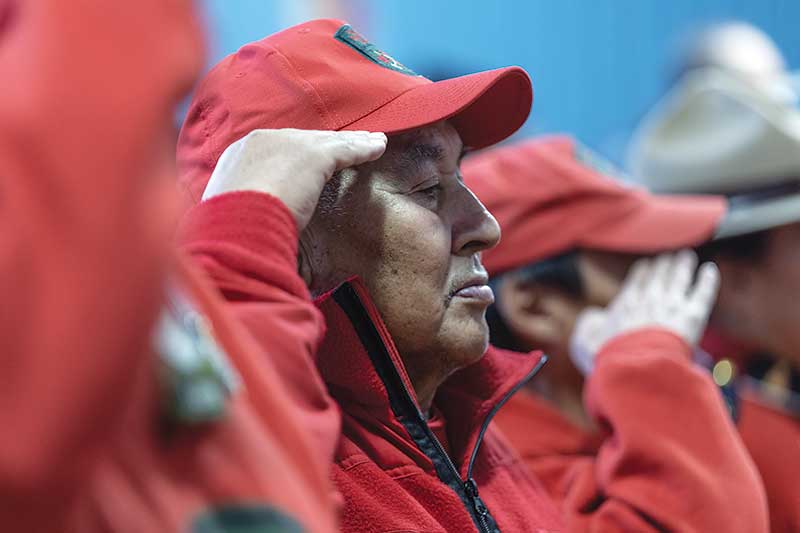
Ranger Jeetaloo Kakee salutes during the 2022 Remembrance Day ceremony in Iqaluit.
On Remembrance Day 2022, as they have for decades, a diversity of people gathered near the southern tip of Canada’s largest island to pay their respects to Canadians who had fallen on fields of battle over the history of this vast country.
It seemed a long way from the politics and conflicts of the world at large, the Air Cadet Hall in Iqaluit where about 200 attendees sheltered from the cold of the territorial capital of Nunavut, on Baffin Island, at the edge of Frobisher Bay.
We will remember them.
There were Legionnaires—long-time residents, many—who had come here as young men for a time and stayed; dignitaries like Eva Aariak, the new commissioner (the territorial equivalent of a lieutenant governor) and former premier; RCMP and military, whose stay here often somehow manages to extend longer than first intended.
There were workers, both bureaucrats and labourers, who had escaped wars and hardships in as unlikely a place as Africa to carve out a living within 320 kilometres of the Arctic Circle; there were young air cadets harbouring dreams, and Inuit who’d made their way here from all over the Arctic in pursuit of opportunity.
The ceremony was conducted in English, French and Inuktut.
The military connection in this remote place remains strong.

As a young Inuk salutes, Mounties march to the 2022 Remembrance Day ceremony in Iqaluit.
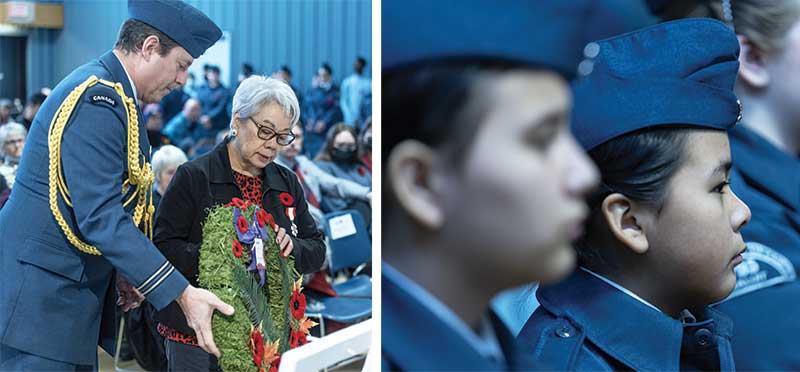
Assisted by her aide-de-camp, Captain Doug Robert, Nunavut Commissioner Eva Aariak places a wreath during the event. The air cadets are a thriving organization in Iqaluit.
In the populous south, it was fall; winter had settled into Iqaluit weeks earlier—though not as many weeks as it used to be, before the time when, Inuit Elders say, the axis of the Earth shifted and the climate changed.
Outside, beyond the settlement of some 7,400 people—an incorporated city, by Nunavut standards—boundless whiteness sprawled in every direction over a rugged and ancient land. A land of caribou, muskox, Arctic wolf and polar bear.
The filtered light of an overcast November morning above the treeline cast long, soft shadows from the war memorial outside the Royal Canadian Legion branch next door. The flags of Canada, Nunavut, Nova Scotia and Britain flapped lazily in a light Arctic breeze coming in off the water, where ice was beginning to form.
Many of those attending the ceremony had set aside their own life challenges for this moment to pause, reflect and remember. Life in Iqaluit, where clean water has been an issue and consumer prices far eclipse those of the south, can be a challenge.
Age shall not weary them, nor the years condemn.
A traditional Inuit fishing port, Iqaluit (“a place of many fish”) became the capital of the new territory of Nunavut, previously part of the Northwest Territories, in 1999.
Its growth and military connection date to the Second World War, when the U.S. Army Air Forces built a refuelling base in what was then called Frobisher Bay for aircraft being ferried to Europe.
Nakasuk, an Inuk guide and ostensibly the area’s first permanent resident, helped planners choose a large flat area for a landing strip in 1941. Dubbed Crystal 2, it was part of the Crimson Route, a set of Canada-U.S. transport routes to Britain that avoided long and vulnerable flights over U-boat-infested waters.
The Crimson project—Crimson was Canada’s codename—was plagued by the extreme darkness and bitter cold of the northern winter. It was cut short in 1943 as the Allies turned the tide of battle in the North Atlantic.
But the infrastructure that had been completed didn’t go to waste. Seeking to capitalize on the facilities at hand, the Hudson’s Bay Company moved its south Baffin operations to nearby Niaqunngut, known as Apex. The weathered company buildings still stand to this day.
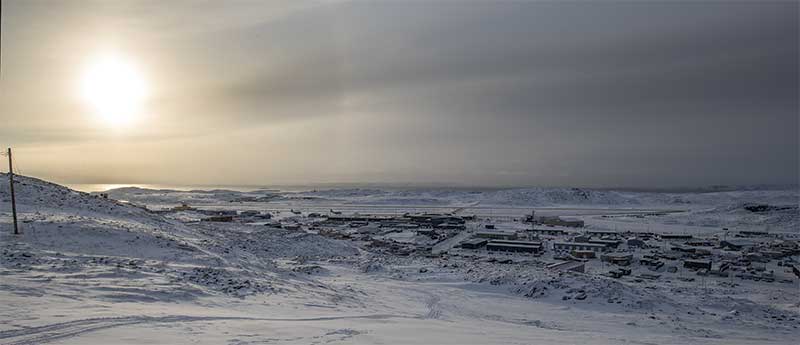
A couple of Hercules C-130 military transports sit on the tarmac at the Iqaluit airport.
The filtered light of an overcast November morning above the treeline cast long, soft shadows from the war memorial.
With the ramping up of the Cold War in the mid-1950s came the chain of Norad radar stations known as the Distant Early Warning Line, or DEW Line. As the centre of the line’s construction, Frobisher Bay was transformed by a relative population explosion.
Hundreds of workers, military personnel and administrative staff moved in from the south and, with the accompanying boost in job prospects and benefits such as better medical care, hundreds of Inuit followed.
By 1957, 489 of the town’s 1,200 residents were reportedly Inuit. The Canadian government expanded its presence, brought in full-time doctors, built a school and established social services. More Inuit came.
A Canadian naval radio station operated for 12 years before it shut down in 1966. The U.S. military left Iqaluit in 1963. The Canadian Armed Forces still maintain a detachment in Iqaluit, Joint Task Force North Nunavut. It played a key role in overcoming a 2021 water crisis.
Some 40-45 RCMP are stationed here, with Nunavut detachments as far north as Grise Fiord, population 144; RCMP presence, two.
RCMP reservist Allen Jagoe was a Mountie for almost four decades before he retired in 2015 and became a provost, escorting prisoners from all over the territory, accompanying some to federal prisons in the south.
A New Brunswicker who had served in Newfoundland for 29 years, he came to “the big city” of Iqaluit with his family in 2005 and stayed.
“I love it up here,” he says. “The simplicity of the place, it’s wonderful. You get to know people. It’s policing at its grassroots.”
Officers have the option to say no to transfers to Nunavut and a typical stay is two to three years. But Jagoe says many ask for extensions and end up staying for two or three rotations.
The North, as they say, gets in your soul.
They served, giving freely of themselves.
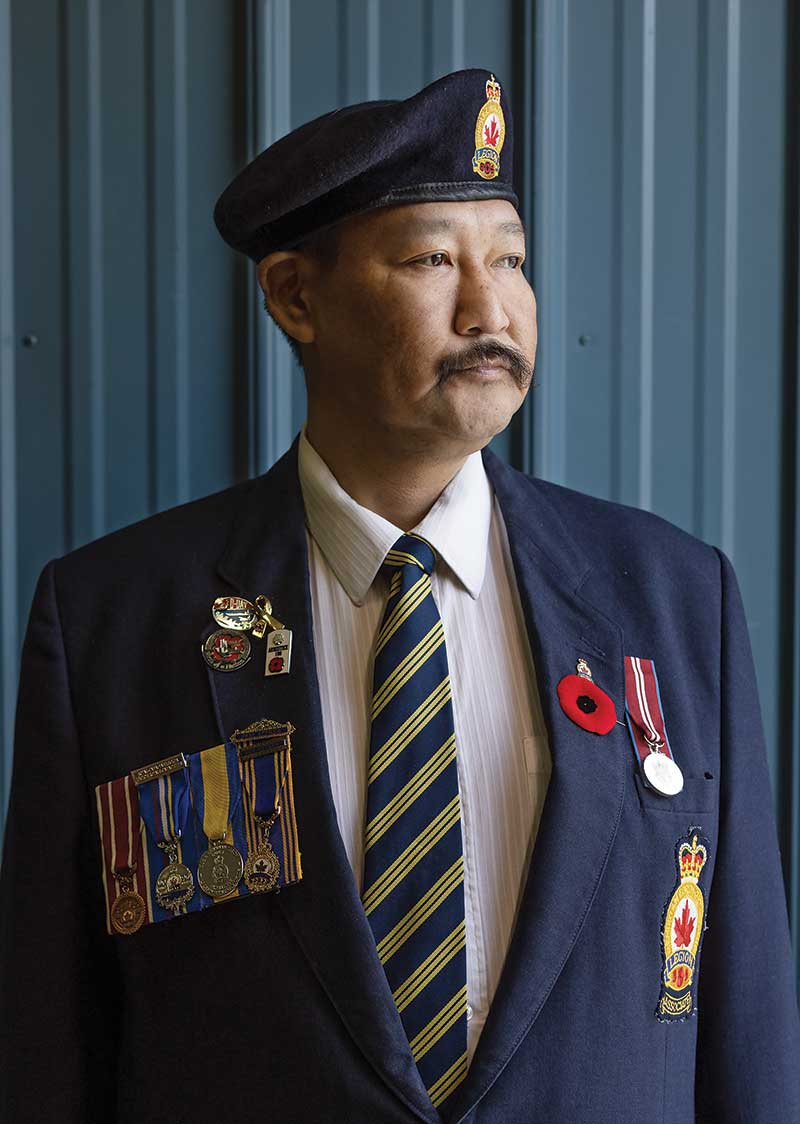
The grandfather for whom Leo Twerdin, secretary-treasurer of the Iqaluit Legion, is named was a member of the 1st Canadian Parachute Battalion during the Second World War and served with the Royal Canadian Regiment in Korea.
The military connection in this remote place remains strong. No. 795 Iqaluit Royal Canadian Air Cadet Squadron is thriving. The Canadian Rangers operate out of Iqaluit, part of 1st Canadian Ranger Patrol Group headquartered in Yellowknife. Hercules military transport aircraft from a variety of countries pass through daily.
At the Remembrance ceremony, a dozen families placed wreaths in memory of veterans, both RCMP and military. The Hanson sisters delivered wreaths in memory of their grandmother Jacqueline, their father Phillip, and their uncle, William; the Thibaudeaus did so for their patriarch Ivan, a Royal Canadian Dragoon; the Mosses for Lieutenant-Commander Michael Stuart Moss, a Royal Navy surgeon.
The Chown and Witzany-Chown families placed a wreath in memory of their grandfather and great-grandfather, WW II veteran Alexander McConnachie, who served six years—the entire war—with the Saint John, N.B., Fusiliers.
There were the Patons, who memorialized Royal Navy veteran Pauline and the British Army’s Jack. The Lalondes covered both world wars: Archibald and Lillian White, who served in WW I, and WW II-era parents and grandparents, Jean-Maurice and Marje (White) Lalonde, a Canadian Women’s Army Corps veteran.
Leo Twerdin, the Legion’s secretary-treasurer, placed a wreath in memory of the grandfather for whom he was named, a Second World War veteran of the 1st Canadian Parachute Battalion who also served with the Royal Canadian Regiment in Korea.
At the going down of the sun.
The sun was already past its peak by the time the ceremony concluded, beginning a tantalizing downward journey that would end in darkness shortly before 3 p.m. It wouldn’t return till almost 8 a.m. the next day. By winter solstice, daylight would be down to just over four hours per day.
It was calm enough that Ranger Patrol Sergeant Kevin Kullualik was going to take his boat out for a few hours of seal hunting. The meat would help feed families whose federal assistance fell short of high housing costs and the exorbitant food prices at local grocery stores, where two litres of almond milk was $14.69, 427 grams of soft margarine was $9.29, and hot house tomatoes were $13.99 a kilo.
Transporting food here is outrageously expensive: $9/kg by sea between June and October; $22/kg by air the rest of the year. Goods are subsidized, but the prices remain staggering: $16.39 for 1.5 litres of orange juice, $27.69 for a dozen half-litre bottles of water, $43.19 for a litre of organic maple syrup.
Yet immigrants come here to make money. A decade ago, the cab drivers were predominantly Lebanese immigrants. Now they’re African from Eritrea, Ethiopia, Sudan and Cameroon. Drivers such as Yonathon, who came to Canada from war-ravaged Eritrea 20 years ago, generally stay for as many as three months at a time, then return to their families in the south—in his case, Calgary—for four weeks.
“You go where the work is,” he said.
We will remember them.
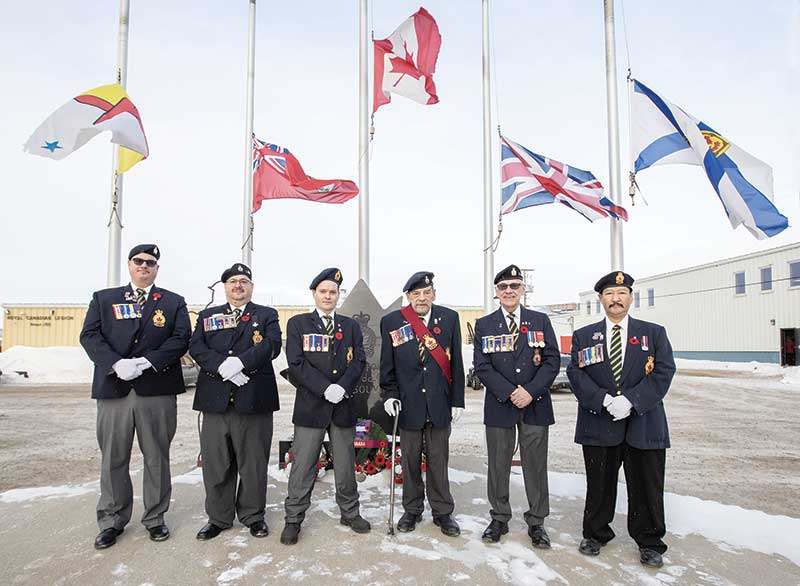
Twerdin is pictured at the Iqaluit war memorial (below, from left) with fellow branch members Chris Ledger, President Clifford Laurin, Second Vice-President Jarrod Selkirk, Sgt.-at-Arms Bob Worches and Past President John Graham.
Advertisement





















